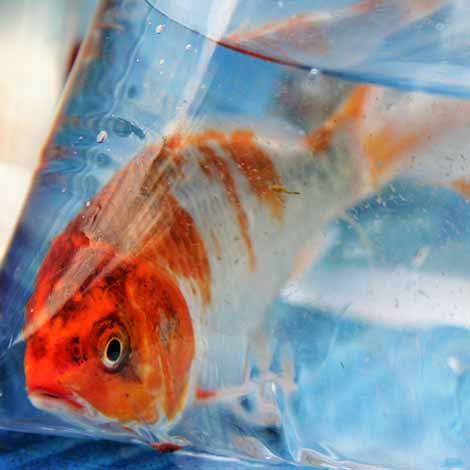Your newly purchased fish are typically handed over to you in an oxygenated plastic bag or container to allow adequate time to transport them to their new home. While it may be tempting to just dump them into your water garden upon your return home, you will want to make sure your pond is ready to accommodate its new inhabitants before you begin their acclimation process. Here are a few things to keep in mind:
Prep Your Pond
Make sure the water in your pond is ready for new occupants by treating for chlorine or heavy metals found in city and tap water. Chlorine can cause burns in fish and on their gills, which in turn will cause even more fish stress. You can accomplish this by adding The Pond Guy Stress Reducer Plus. You should also test pond water for acceptable pH and nitrate levels in the pond. Many potential issues can be avoided by simply maintaining a clean pond.
Inspect Before You Select
It is easy to get attached to that perfect fish right from the start but be sure to make sure they are feeling ready to travel. Some common signs to look for are clamped fins, open sores or separating themselves from other fish in the tank. Choosing a fish that is well right from the start ensures more successful transportation.
Transportation Home
Your newly purchased fish are typically handed over to you in an oxygenated plastic bag or container to allow adequate time to transport them to their new home. As you travel be sure to keep fish in a cool dim location to keep them calm and keep water cool. Cooler water will also hold more valuable oxygen that your fish will need as they travel.
Acclimate Your Fish to Their New Environment
- Equalize water temperature. Most of us have, at one time or another, jumped into a pool too early in the summer only to find that the water is unimaginably cold. Those who have been in that situation understand why you will want to take your time with the acclimation process. You will want to gradually equalize the temperature of the water your fish are currently occupying with that of the water in your pond. Take the bag out of the box, and before releasing the koi into the pond, float the bag (with the fish inside) in the pond water for 7-10 minutes. Floating the bag helps the fish acclimate to the water temperature of the new environment.
- Introduce pond water slowly. Open the bag (fish remains in the bag) and add some pond water to the bag. Close the bag with the fish still inside, allowing 2-5 minutes to help the fish acclimate to the water quality in the new environment.
- Repeat. Continue adding small amounts of water from the pond into the bag for 2-5 minutes, allowing your new fish time to acclimate to the chemistry of your pond water.
- Release and Check-Up. Now that the water on both sides of the bag is the same and the fish have had time to try out the makeup of the water in the pond, you are clear to release them into their new environment! Open the bag and release the fish into the pond. When transferring the fish from the bag to the pond, it is recommended to use a net to avoid water from the bag entering your pond. Take a few moments throughout the day to check in on the pond and monitor the behavior of the newly introduced fish. Active and curious fish are happy and thriving fish.
Overwintered Fish
Re-introducing your fish to their summer home can be a safe and simple process if you overwinter them indoors.
- Perform a Pond Cleanout: Clean your rocks, waterfall, filters and pond equipment. If stuck-on debris are slowing you down, use some The Pond Guy Oxy-Lift Defense to speed up the process. Be sure to clean out any bottom-dwelling muck and skim out floating debris. Most people drain their ponds for easier access to the entire pond. If you are not up to the task, then perform at least a 20% water change.
- Seed & Start Your Filters: Once you refill the pond, replace or clean Filter Media Pads and secondary media like The Pond Guy BioBalls. Use Microbe-Lift PL Gel to introduce beneficial bacteria and reduce filter seed time. Once everything is back in place, start your pumps and let the water flow. Be sure to test your water for ammonia before adding your fish. See our article on Understanding the Nitrogen Cycle for tips on how to know when your pond is ready.
- Acclimate Your Fish: Water temperature and composition will be different than their winter housing, so it is important to slowly introduce them to their new home. Bring fish out in a bucket and periodically add a small amount of pond water every 5-10 minutes. This will give your fish time to adjust to the water variations and avoid shock. After 15-20 minutes, it will be safe to gently release the fish back into their home.
